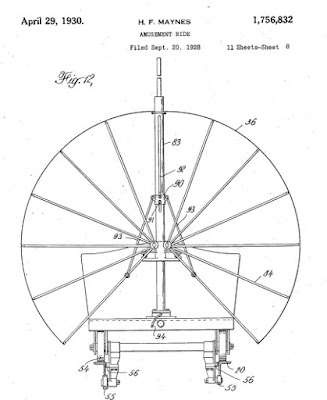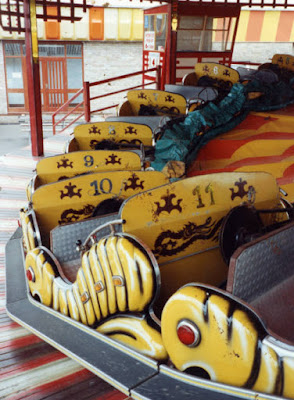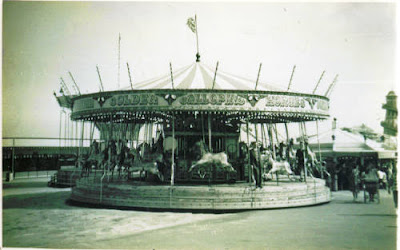Super Loops was a popular ride during the four seasons from 1982 that it operated at Pleasure Beach, and it was immortalised in Madness' House of Fun music video. The ride wasn't popular all-round though, and nearly didn't make it through its first season.
 |
| Super Loops at Pleasure Beach in 1982. Reproduced with permission from the University of Sheffield. |
Walter House, from Amarillo, Texas, developed the Super Loops ride concept and built three prototypes, each with a height of around 40ft, one of which toured North American carnivals and fairs for many years. House sold the rights to the name and concept to Larson International, which had been set up in 1965 to manufacture agricultural machinery. Larson International engineer Louie Wallace redesigned the ride from the ground up and the first machine was completed in the early 1970s. They feature a 55ft (17m) tall vertical loop of track on which a 20-person train runs. Despite its operational size, Wallace engineered an ingenious hydraulic system which could automatically unfold the loop of track from a single trailer, which was further supported by outriggers and cables that were fixed manually. Wallace's design allowed operators to construct the ride in less than three hours, making it an extremely attractive option for travelling showmen.
Follow this link for YouTube video of the ride in operation at the Texas State Fair of 1975, and an interview with Walter House about the ride (and an unfortunate incident).
Follow this link for YouTube video of the ride in operation at the Texas State Fair of 1975, and an interview with Walter House about the ride (and an unfortunate incident).
An arrangement called an inertia ring runs the length of the track and is attached to the train. A tyre drive, mounted under the track, drives the inertia ring and thus the train. Motion is akin to building up momentum on a swing, until finally the train has enough momentum to complete the loop. Its maximum speed is 34mph (55kph). The operator controls the ride using a toggle lever which determines the direction and speed of travel. The operator's chair also acts as a deadmans control, and the operator needs to be seated for the toggle lever to work, so as to prevent accidental movement of the ride.
 |
| Super Loops specification. Credit: ride-extravaganza.com |
The train seats 20 riders (10x2) and features lap bar restraints controlled by compressed air. The operator has to manually connect a compressed air line to the train to release the restraints. The train has a caged roof to provide another means of containment, should that prove necessary. The ride was popular and offered riders a thrill, in particular hang-time, which few other rides at the time could compete with.
Super Loops opened at Pleasure Beach for the 1982 season. Whilst it was popular with visitors, residents living opposite Pleasure Beach complained bitterly about the noise. The complaints centered on two aspects - the general intrusive sound of the ride when it was running, which was caused by the sound of the numerous wheels of the inertia ring on the track, and the unpleasant squealing sound the drive tyre occasionally made, particularly during wet weather.
Not long after the ride opened, residents had a petition for it’s closure. The complaint was investigated by the Council, and within weeks the ride was moved from the position it was originally installed, south of the Scenic Railway, to a position near the very end of the park, adjacent to an arcade and giant slide ride there at the time. It was hoped this would provide some shielding to the noise. Unfortunately, it had little effect on the situation as far as the residents were concerned, and another petition for removal of the ride followed. The local public health officer was involved and the Council and residents considered taking legal action to force the ride's closure, citing anti-pollution laws.
Not long after the ride opened, residents had a petition for it’s closure. The complaint was investigated by the Council, and within weeks the ride was moved from the position it was originally installed, south of the Scenic Railway, to a position near the very end of the park, adjacent to an arcade and giant slide ride there at the time. It was hoped this would provide some shielding to the noise. Unfortunately, it had little effect on the situation as far as the residents were concerned, and another petition for removal of the ride followed. The local public health officer was involved and the Council and residents considered taking legal action to force the ride's closure, citing anti-pollution laws.
The future of the ride looked uncertain. In the end, the ride was moved again, to the north end of the park near the entrance. This, and replacement wheels for the inertia ring reduced the noise of the ride to a level residents found acceptable. After all this, the ride had a relatively short-lived existence at Pleasure Beach, and it moved to Mexico following the 1986 season.
 |
| Madness on the Super Loops in 1982 during filming of scenes for the music video for their single House of Fun. The video shows Super Loops in its original location, just south of the Scenic Railway. |
 |
| Super Loops features prominently in this advertisement for Pleasure Beach from 1983. |
Although Pleasure Beach’s Super Loops is consigned to history, rides of this type continue to be popular. Improvements were made, including a redesigned inertia ring to reduce noise and maintenance and the ride renamed Ring of Fire in the 1980s. This was followed by the Fire Ball model, which premiered in 1998, and features an open train with over-shoulder restraints instead of lap bars. Larson International still manufacture this model, and the various models are collectively referred to as Larson Loops among enthusiasts. I don't believe there are any now operating in the UK, although they attend a variety of fairs and carnivals in the US. The most recent versions are rather taller - up to 100ft, feature open trains with over-shoulder restraints and computer control. Such rides can be found as permanent installations at many Six Flags parks, and other theme parks in the US.






























